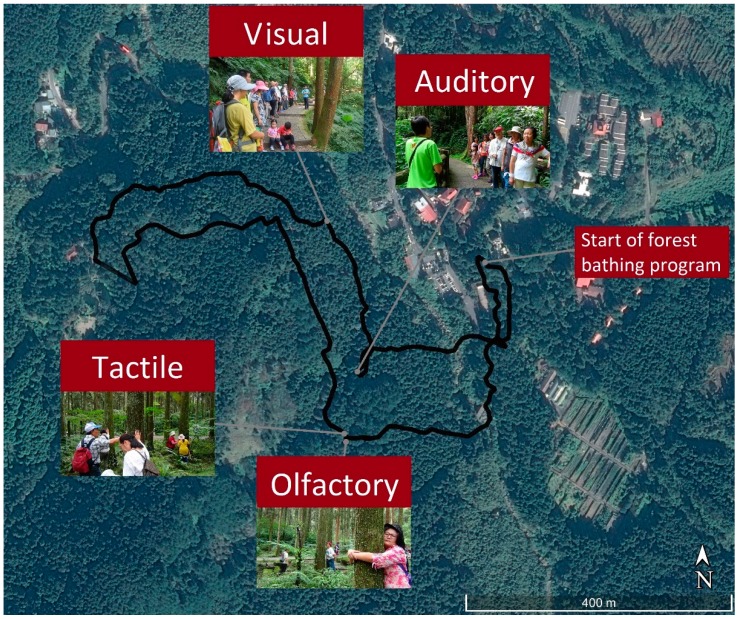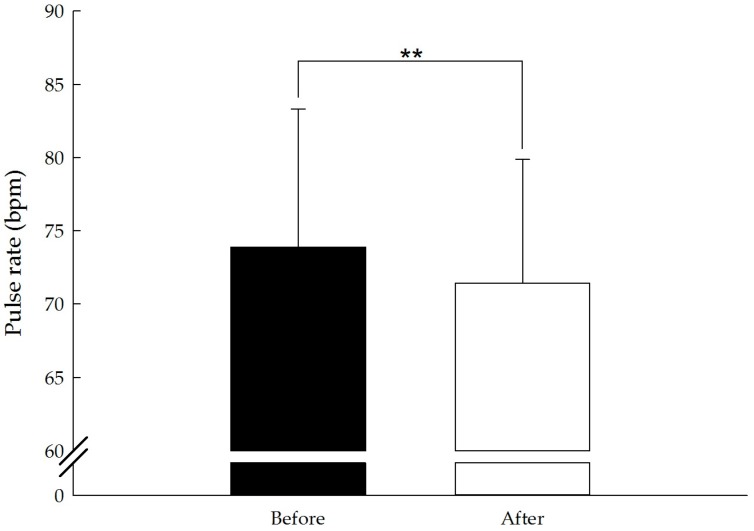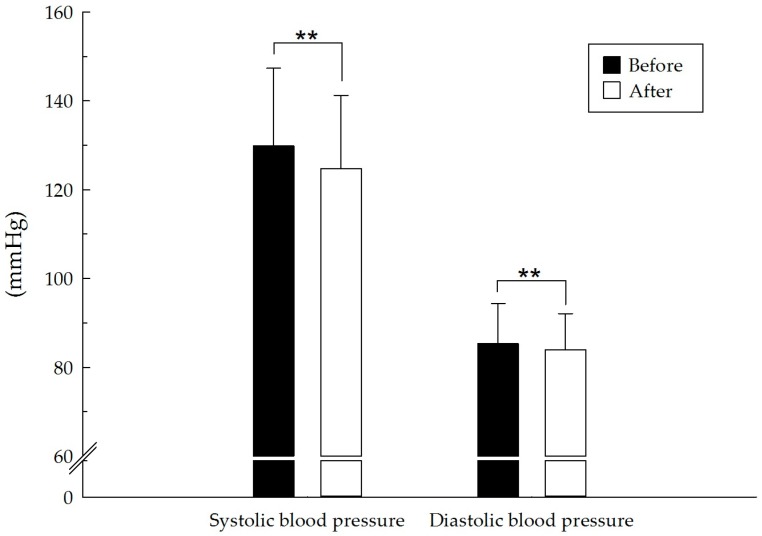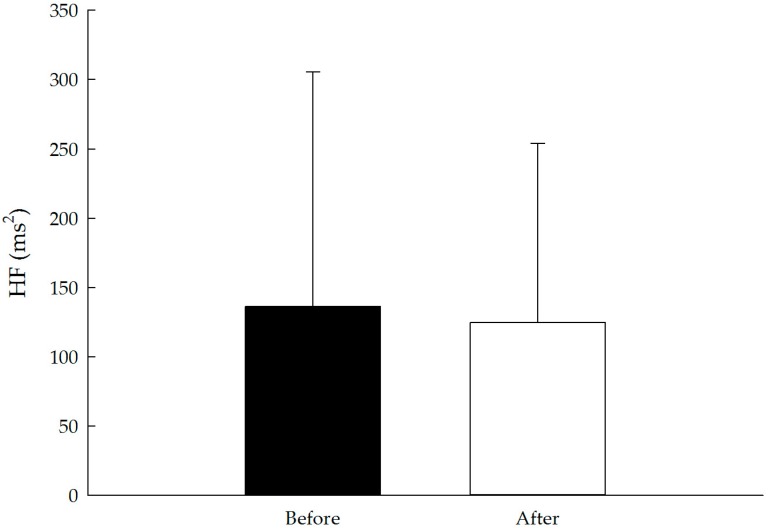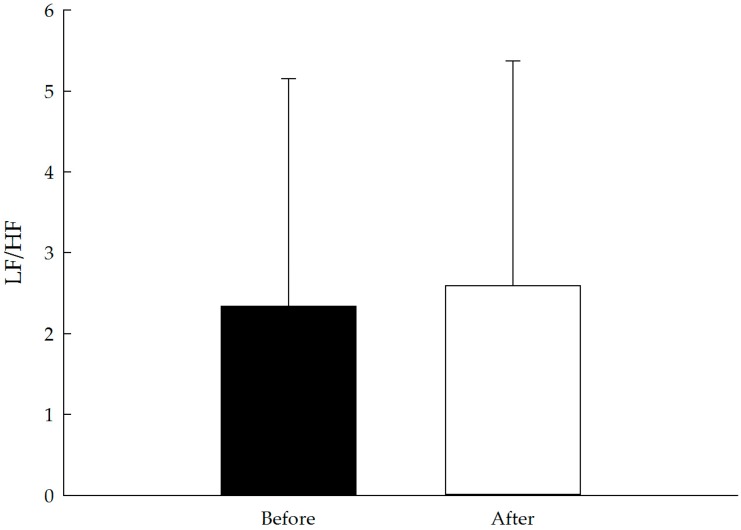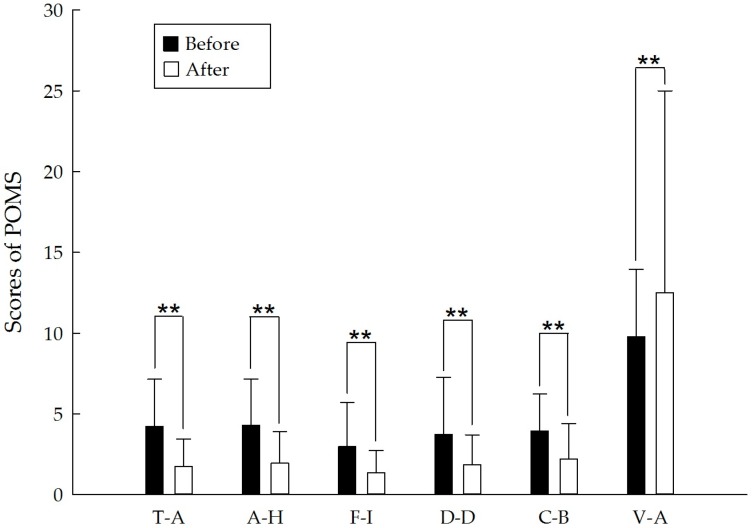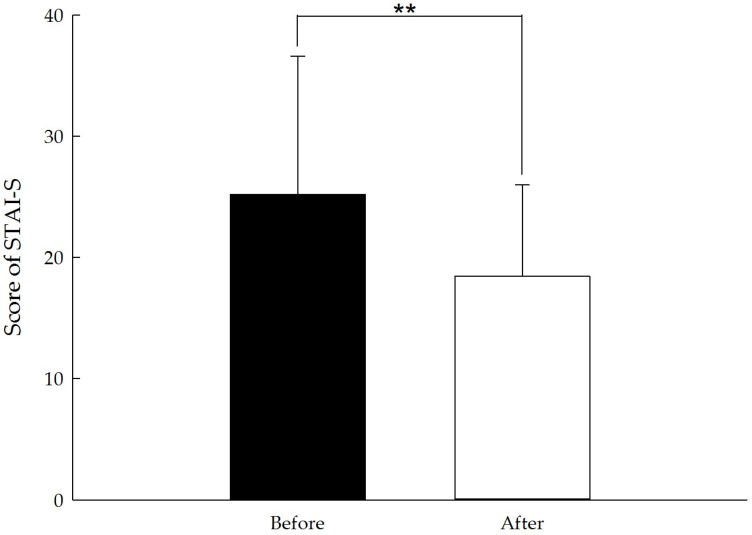Abstract
The present study investigated changes in autonomic nervous system activity and emotions after a short (2 h) forest bathing program in the Xitou Nature Education Area (XNEA), Taiwan. One hundred and twenty-eight (60.0 ± 7.44 years) middle-aged and elderly participants were recruited. Physiological responses, pulse rate, systolic and diastolic blood pressure, heart rate variability (HRV), and psychological indices were measured before and after the program. We observed that pulse rate, systolic and diastolic blood pressure were significantly lower after the program, which indicated physiological benefits from stress recovery. The Profile of Mood States negative mood subscale scores of “tension-anxiety”, “anger-hostility”, “fatigue-inertia”, “depression-dejection”, and “confusion-bewilderment” were significantly lower, whereas the positive mood subscale score of “vigor-activity” was higher. Furthermore, participants exhibited significantly lower anxiety levels according to the State-Trait Anxiety Inventory. However, changes in sympathetic and parasympathetic nerve activity were nonsignificant. Our study determined that the short forest bathing program is a promising therapeutic method for enhancing heart rate and blood pressure functions as well as an effective psychological relaxation strategy for middle-aged and elderly individuals.
Keywords: forest bathing, pulse rate, blood pressure, heart rate variability, Profile of Mood States, State-Trait Anxiety Inventory, middle-aged and elderly
1. Introduction
As human society becomes increasingly urbanized, various physiological and psychological diseases are caused by stress, thus affecting humans’ well-being and health [1,2]. Studies of leisure activities have identified the following benefits that potentially relieve stress and improve quality of life. Physiologically, leisure activities can relieve tension and fatigue, ameliorate disease, and enhance physical fitness to help people achieve health goals. Psychologically, leisure activities enable participants to relieve stress from life activities, relax mentally and physically, balance their moods, and obtain peak experiences. Socially, leisure activities improve the development of interpersonal relationships, harmonious relationships and friendships [3,4,5]. To improve health and well-being, studies have investigated various relaxation approaches such as yoga, massage, meditation, green attractions, and forest bathing [6,7,8,9,10,11,12,13,14]. In many Asian countries, forest bathing is a widespread outdoor activity and an alternative health-promotion approach [7]. Forest bathing or forest therapy refers to immersing oneself in nature and experiencing a forest’s atmosphere to improve mental and physical health [10,15,16,17,18,19]. A five-senses experience from walking or staying in a forest was reported to relieve stress and thus yield health benefits [20].
Several studies have determined that being in a forest environment has health benefits; participants in such an environment have lower pulse rates and diastolic and systolic blood pressures [6,7,21,22,23,24,25,26,27,28] than in urban settings. Decreased sympathetic nervous activity [7,20,22,23,24,29], cortisol levels [6,15,20,22,24,30], and salivary amylase activity [31] have been reported, as well as increasing parasympathetic nervous system activity [7,20,22,23,24,26,29]. Improved natural killer (NK) cell numbers and activity as well as percentages of granulysin, perforin and granzymes A/B have also been reported, indicating benefits to the human immune system [8,32,33,34]. The effect of forest visits on mental health has also been investigated in studies that have applied the Profile of Mood States (POMS) and determined that forest experiences increase positive emotions and reduce negative mood states [7,22,25,35,36,37,38,39,40,41] in comparison with urban stimuli. Some studies have also reported improvements in other psychological responses, including anxiety and depression [9,28,29,42,43,44].
Japan currently leads this field of research and has accumulated a large amount of scientific data on forests and human health. Substantial research on the Japanese practice of forest bathing (shinrin-yoku) has explored using forests for public health [45]. Taiwan aspires to diversify the use of forest services, particularly to promote forest and human health and well-being. For example, the Taiwan Forestry Bureau and the Experimental Forest of National Taiwan University (NTU) are developing forest bathing programs (e.g., Sensory Forest) for public use. Consequently, there is a need for understanding the health benefits of a specific forest bathing program. Additionally, considering diverse factors, such as forest type, environmental conditions, biodiversity, program content, and cultural background, this type of study is sensitive to the context of the environment, program, and participants, largely because of differences in trails, temperature and scenery. For example, the beneficial health effects derived from walking through a forest in Japan may differ from those derived from walking through a forest in Taiwan. Therefore, understanding the effects of forest bathing experience on human psychological and physiological responses in the local context is imperative. Furthermore, the major limitation of existing forest bathing research is small sample sizes and the fact that most studies have involved healthy (generally young and student) volunteers [10,44]. In order to make inferences at a population level, more research is required on the specific subgroups that might benefit most from forest exposure [45,46,47].
To this end, the present study investigated the autonomic nervous system activity and emotions of a large sample of middle-aged and elderly participants through field experiments and a one-group pretest–posttest design. Specifically, pulse rate, systolic and diastolic blood pressure, HRV, and mood states were measured before and after the popular short forest bathing program, Sensory Forest, which is provided by the Xitou Nature Education Area (XNEA). This study sought to understand the physiological and psychological effects of the short forest bathing program on middle-aged and elderly individuals.
2. Materials and Methods
2.1. Participants
One hundred and twenty-eight middle-aged and elderly subjects aged 45 to 86 years (60.0 ± 7.44; mean ± standard deviation) were recruited to the field experiment. The distributions of participants were 85 females (66.4%) and 43 males (33.6%); 59 subjects (46.1%) reported chronic diseases including diabetes, hypertension, heart and other diseases. The details and the frequency of natural recreation experience were reported in Table 1. All participants were capable of completing the forest bathing program and assessed initially to ensure that they had not consumed stimulants (i.e., alcohol and caffeine) prior to the experiment. The participants were fully informed about the study aims and procedures and voluntarily signed a participation agreement. A human subject’s compliance agreement was submitted to the Research Ethics Office of National Taiwan University; approval was received on 16 November 2015 (NTU-REC No. 201510HM015).
Table 1.
Summary of sample characteristics (N = 128).
| Variable | Group | Number of Participants | Percentage |
|---|---|---|---|
| Gender | Male | 43 | 33.6% |
| Female | 85 | 66.4% | |
| Chronic diseases | Diabetes | 9 | 7.0% |
| Hypertension | 25 | 19.5% | |
| Heart diseases | 8 | 6.3% | |
| Other diseases | 17 | 13.3% | |
| None | 69 | 53.9% | |
| Natural recreation experience | Once per month | 40 | 31.2% |
| 2–3 times per month | 37 | 28.9% | |
| More than 4 times per month | 51 | 39.9% |
2.2. Study Sites
The field experiment site was in the planted forest mainly containing Cryptomeria japonica (1200–3000 per hectare) and Phyllostachys pubescens (3000–4500 per hectare) and the stand age ranged between 40 and 90 years old in XNEA, which is managed by the Experimental Forest of NTU and situated in central Taiwan. XNEA is a valley surrounded by mountains on three sides. The altitude of the forest area is from 800 to 2000 m; the temperature ranges from 11.0 to 20.8 °C (annual average temperature of 16.6 °C); and the humidity ranges from 88.0 to 93.0%. During the days of the forest bathing program, the weather was pleasant and it was not raining with a temperature of 22.6 ± 1.4 °C; 87.4 ± 3.8% relative humidity; wind speed of 0.1 ± 0.2 m/s.
2.3. Research Design
Participants were recruited from the XNEA main entrance. This study adopted a one-group pretest–posttest field experimental design to evaluate the autonomic nervous system activity and mood states incurred by the forest bathing program. Specifically, all participants were measured for their physiological and psychological responses before the forest bathing program (baseline), and post-program measures were collected upon their return. The effects of the forest bathing program on autonomic nervous system activity and mood states could therefore be identified by comparing the baseline and posttest measurements.
This study was conducted from 8:30 a.m. to 12:00 p.m. from 15 to 27 July 2016. Pretest and posttest data were collected from 8:30 to 9:15 a.m. and 11:15 a.m. to 12:00 p.m. The investigation was conducted once a day in the morning to limit changes in temperature, humidity, wind speed, and light levels. A guided 2 h forest bathing program (Sensory Forest) was organized to include the stimulation of four senses, namely visual (e.g., scenery), auditory (e.g., the sound of running streams or birds singing), olfactory (e.g., the smell of wood), and tactile (e.g., feeling the surfaces of leaves and trees) to facilitate the forest bathing experience (Figure 1). The total distance was 2.5 km, with an altitude of 1166–1192 m; the average walking speed was around 2 km/h and the walking course had a slight slope (5%). All participants completed the short trip smoothly. Consumption of alcohol, tobacco and caffeine was prohibited during the study period. The study set a maximum of 12 participants in each group that ensures quality of the program. The numbers of participants on each day were 8, 7, 6, 8, 8, 13, 16, 13, 10, 6, 11, 12 and 10 during 15–27 July 2016.
Figure 1.
Walking course and various activities of the forest bathing program superimposed on a location map.
2.4. Physiological Indices
Pulse rate, systolic and diastolic blood pressure, and HRV were measured to assess autonomic nerve system activity. Pulse rate and systolic and diastolic blood pressure were obtained from the nondominant arm using a portable digital sphygmomanometer (EW-BW33, Panasonic Ltd., Osaka, Japan). The low-frequency (LF) and high-frequency (HF) data were measured using a handheld HRV monitor (LR-8Z11, Yang Ying Corporation Ltd., Taiwan). The HRV frequency spectrum comprises LF (0.04–0.15 Hz) and HF (0.15–0.40 Hz). The HF component is an estimate of parasympathetic nerve activity, whereas the LF/HF ratio reflects sympathetic nerve activity [30,48].
2.5. Psychological Indices
The Chinese versions of two psychological scales with satisfactory validity and reliability, namely the POMS and State-Trait Anxiety Inventory (STAI), were administered prior to and following the forest bathing program. The POMS was used to evaluate the psychological responses to forest therapy [49]. The POMS comprises 37 adjectives following six subscales: “tension-anxiety”, “anger-hostility”, “fatigue-inertia”, “depression-dejection”, “confusion-bewilderment”, and “vigor-activity.” Anxiety level was investigated using the STAI state anxiety subscale [50].
2.6. Data Analysis
All statistics analysis was performed using SPSS 20.0 (IBM Corporation, Armonk, NY, USA). A paired sample t-test was conducted to compare the differences between the pretest and posttest measurements. Data are expressed as the mean ± standard error (mean ± SE). In all comparisons, a p-value of <0.05 was considered statistically significant. Effect size was reported using Cohen’s d.
3. Results
The results for pulse rate (pre 73.9 ± 9.4, post 71.4 ± 8.4 beats/min; t(127) = −4.82, p < 0.01, d = 0.43) and systolic (pre 129.9 ± 17.5, post 124.8 ± 16.5 mmHg; t(127) = −6.80, p < 0.01, d = 0.60) and diastolic blood pressure (pre 85.3 ± 9.1, post 84.4 ± 8.1 mmHg; t(127) = −2.70, p < 0.01, d = 0.24) were significantly lower after the forest bathing program. No significant change was observed in HF and LF/HF. The results of the physiological evaluation are presented in Table 2 and Figure 2, Figure 3, Figure 4 and Figure 5.
Table 2.
Effect of the forest bathing on physiological indices.
| Physiological Indices | Pretest | Posttest | p | t | Effect Size |
|---|---|---|---|---|---|
| Pulse rate (bpm) | 73.9 ± 9.4 | 71.4 ± 8.4 | 0.000 ** | −4.82 | 0.43 |
| Systolic blood pressure (mmHg) | 129.9 ± 17.5 | 124.8 ± 16.5 | 0.000 ** | −6.80 | 0.60 |
| Diastolic blood pressure (mmHg) | 85.3 ± 9.1 | 84.0 ± 8.1 | 0.008 ** | −2.70 | 0.24 |
| High-frequency (HF) (ms2) | 136.5 ± 169.0 | 124.7 ± 129.3 | 0.345 | −0.95 | 0.08 |
| Low-frequency (LF)/HF | 2.3 ± 2.8 | 2.6 ± 2.8 | 0.199 | 1.29 | 0.11 |
** p < 0.01, paired-sample t test. HF: high frequency; LF: low frequency.
Figure 2.
Effect of the short forest bathing program on pulse rate. N = 128, mean ± standard error. ** p < 0.01, paired-sample t test.
Figure 3.
Effect of the short forest bathing program on systolic and diastolic blood pressure. N = 128, mean ± standard error. ** p < 0.01, paired-sample t test.
Figure 4.
Effect of the short forest bathing program on HF. N = 128, mean ± standard error. Paired-sample t test.
Figure 5.
Effect of the short forest bathing program on LF/HF. N = 128, mean ± standard error. Paired-sample t test.
All of the POMS and STAI scores revealed significant improvements after the forest bathing program. Five of the negative subscales of the POMS, “tension-anxiety,” “anger-hostility,” “fatigue-inertia,” “depression-dejection,” and “confusion-bewilderment,” decreased from pretest to posttest (all p < 0.01). Conversely, the positive mood state “vigor-activity” significantly increased (p < 0.01), and the state anxiety subscale in the STAI measurement exhibited improvements (p < 0.01). The POMS and STAI scores are presented in Table 3 and Figure 6 and Figure 7.
Table 3.
Effect of forest bathing on emotional state and anxiety.
| Variables | Subscales | Pretest | Posttest | p | t | Effect Size |
|---|---|---|---|---|---|---|
| Emotional states (POMS) | tension-anxiety | 4.22 ± 2.92 | 1.73 ± 2.19 | 0.000 ** | −12.20 | 1.08 |
| anger-hostility | 4.30 ± 2.87 | 1.95 ± 2.52 | 0.000 ** | −10.95 | 0.97 | |
| fatigue-inertia | 2.98 ± 2.72 | 1.36 ± 1.95 | 0.000 ** | −8.04 | 0.71 | |
| depression-dejection | 3.73 ± 3.52 | 1.85 ± 2.65 | 0.000 ** | −7.70 | 0.68 | |
| confusion-bewilderment | 3.93 ± 2.30 | 2.20 ± 2.00 | 0.000 ** | −10.46 | 0.92 | |
| vigor-activity | 9.77 ± 4.17 | 12.57 ± 4.47 | 0.000 ** | 9.00 | 0.80 | |
| Anxiety (STAI-S) | state anxiety | 25.22 ± 11.39 | 18.44 ± 7.55 | 0.000 ** | −8.45 | 0.75 |
** p < 0.01, paired-sample t test. POMS: the Profile of Mood states; STAI: State-Trait Anxiety Inventory.
Figure 6.
POMS scores before and after the short forest bathing program. T-A: tension-anxiety; A-H: anger-hostility; F-I: fatigue-inertia; D-D: depression-dejection; C-B: confusion-bewilderment; V-A: vigor-activity. N = 128, mean ± standard error. ** p < 0.01, paired-sample t test.
Figure 7.
STAI-S score before and after the short forest bathing program. N = 128, mean ± standard error. ** p < 0.01, paired-sample t test.
4. Discussion
This study explored the physiological and psychological responses to a short forest bathing program among middle-aged and elderly individuals. Pulse rate, systolic blood pressure, and diastolic blood pressure were determined to be significantly lower after the program. Previous studies have shown that heart rate and blood pressure are significantly lower in forest environments than in urban environments [6,7,19,23,24,25,26]. However, these studies have not indicated the efficacy of forest bathing per se in terms of stress reduction. Our findings indicated stress recovery as a result of the forest bathing program. Therefore, we concluded that the forest bathing program benefits pulse rate, systolic and diastolic blood pressure functions to middle-aged and elderly people.
Sympathetic and parasympathetic nerve activity can be determined by measuring HRV. In this context, most studies have reported that, compared with exposure to urban settings, exposure to forest environments results in higher parasympathetic and lower sympathetic nervous activity [7,15,22,29]. Our results offer a contrast at nonsignificant levels, namely a decrease in parasympathetic nerve activity and an increase in sympathetic nerve activity. It remains unclear as to why no significant change occurred in sympathetic and parasympathetic nerve activity in our study. It might be simply that the short forest bathing experience had limited effects on both the sympathetic and parasympathetic nervous systems. Or, unlike previous studies, sympathetic nerve activity and parasympathetic nerve activity were evaluated between time points within a single environment rather than between forest and urban environments in this study. Another possible explanation is that forest bathing experience combines enjoying the forest environment and walking in it. Enjoying the forest environment was expected to result in relaxation, which could increase parasympathetic nerve activity and suppress sympathetic nerve activity. However, physical exercise (i.e., walking or hiking) consumed individuals’ energy, and we suggested to participants that they pay attention to our program instructor; both of these factors may have boosted sympathetic nerve activity. We suggest that future studies explore potential variable-influenced physiological effects, for example, intensity of exercise (energy expenditure level), non-guided and guided forest bathing programs and/or environmental conditions (level of slope, humidity and atmospheric pressure). This information can greatly contribute to the development of the forest bathing program and forest management.
The POMS questionnaire results showed that the positive mood state of vigor was higher and the negative mood states of tension, anger, fatigue, depression and confusion were significantly lower after the forest bathing program. Additionally, state anxiety level decreased. These findings indicate that the short forest bathing program had psychological benefits for middle-aged and elderly people, which is consistent with the findings of previous studies [7,22,25,32,35,36,37,38,39,40,41]. Therefore, we concluded that the effects of psychological stress recovery of the forest bathing program extends to middle-aged and elderly people.
Forest bathing is an effective and convenient method of detaching oneself from urban environments. Undertaking activities in natural environments relieves stress and anxiety and thus improves health. Taiwan’s elderly population is growing rapidly. Currently, 13.3% of people are aged 65 years or older [51]. Evaluating the effects of the short forest bathing program on psychological and physiological benefits could help develop this type of program, provide proof of its effectiveness, and encourage the public to connect with nature. Furthermore, forest-based activities provide an opportunity for social interaction, allowing middle-aged and elderly people not only to enjoy the natural environment but also make new friends, which further contributes to their mental health. From a public health perspective, forest bathing is a simple and cost-effective method for improving health. Considering that 60% of Taiwan is forest-covered, forest bathing could be an effective health-promotion approach that could in turn reduce national medical expenses.
The present findings provide scientific evidence that the forest bathing program confers psychological and physiological benefits in middle-aged and elderly individuals by investigating a large sample size. Although some studies have suggested that longer forest bathing programs have a more beneficial effect [7], the present study clearly demonstrated that among middle-aged and elderly individuals, the short forest bathing program was associated with stress recovery. The short forest bathing program, Sensory Forest, could therefore become an effective forest therapy treatment and provide preventive benefits for stress-related illnesses to the specific group for enhancing their mental and physical health. However, the limitations of the present study include failing to collect information of confounding variables such as socio-economic status, medication usage, habits (e.g., smoking, exercise, etc.) and personality (e.g., nature lover), which potentially affect the physiological and psychological effects of forest bathing experience. Additionally, environmental factors such as forest aesthetics, types and levels of pollutions and environmental conditions should be included as covariates. Future studies should consider a range of subjects’ characteristics and/or micro-environmental conditions.
5. Conclusions
Our study revealed that the short forest bathing program elicited a significant decrease in pulse rate and systolic and diastolic blood pressure in middle-aged and elderly individuals. A short walk in the forest can reduce tension, anger, fatigue, depression, confusion and anxiety as well as improve positive emotion. However, sympathetic and parasympathetic nerve activity saw no improvement. In conclusion, the short forest bathing program contributes physiological and psychological healthy benefits on middle-aged and elderly people.
Acknowledgments
This study was conducted with the support of the Ministry of Science and Technology of Taiwan under research grant 105-2628-H-002-004-MY2. We thank the cooperation of the Experimental Forest of National Taiwan University during this study.
Author Contributions
Chia-Pin Yu and Chia-Min Lin contributed to the experimental design, data acquisition, statistical analysis, and manuscript preparation. Ming-Jer Tsai contributed to the experimental design and coordination of the study site. Yu-Chieh Tsai contributed to the analysis and interpretation of results. Chun-Yu Chen contributed to preparing the study site and data acquisition. All authors have read and approved the final version submitted for publication.
Conflicts of Interest
The authors declare no conflict of interest.
References
- 1.Dye C. Health and urban living. Science. 2008;319:766–769. doi: 10.1126/science.1150198. [DOI] [PubMed] [Google Scholar]
- 2.Wagner K.-H., Brath H. A global view on the development of non communicable diseases. Prev. Med. 2012;54:S38–S41. doi: 10.1016/j.ypmed.2011.11.012. [DOI] [PubMed] [Google Scholar]
- 3.Bright A.D. The role of social marketing in leisure and recreation management. J. Leis. Res. 2000;32:12. [Google Scholar]
- 4.Driver B.L., Tinsley H., Manfredo M.J. The paragraphs about leisure and recreation experience preference scales: Results from two inventories designed to assess the breadth of the perceived psychological benefits of leisure. In: Driver B.L., Brown P.J., Peterson G.L., editors. Benefits of Leisure. Venture Publishing; State College, PA, USA: 1991. pp. 263–286. [Google Scholar]
- 5.Verduin J.R., Jr., McEwen D.N. Adults and Their Leisure: The Need for Lifelong Learning. Charles C. Thomas Publisher Ltd.; Springfield, IL, USA: 1984. [Google Scholar]
- 6.Lee J., Park B.-J., Tsunetsugu Y., Kagawa T., Miyazaki Y. Restorative effects of viewing real forest landscapes, based on a comparison with urban landscapes. Scand. J. For. Res. 2009;24:227–234. doi: 10.1080/02827580902903341. [DOI] [Google Scholar]
- 7.Lee J., Park B.-J., Tsunetsugu Y., Ohira T., Kagawa T., Miyazaki Y. Effect of forest bathing on physiological and psychological responses in young Japanese male subjects. Public Health. 2011;125:93–100. doi: 10.1016/j.puhe.2010.09.005. [DOI] [PubMed] [Google Scholar]
- 8.Li Q. Effect of forest bathing trips on human immune function. Environ. Health Prev. Med. 2010;15:9–17. doi: 10.1007/s12199-008-0068-3. [DOI] [PMC free article] [PubMed] [Google Scholar]
- 9.Morita E., Fukuda S., Nagano J., Hamajima N., Yamamoto H., Iwai Y., Nakashima T., Ohira H., Shirakawa T. Psychological effects of forest environments on healthy adults: Shinrin-yoku (forest-air bathing, walking) as a possible method of stress reduction. Public Health. 2007;121:54–63. doi: 10.1016/j.puhe.2006.05.024. [DOI] [PubMed] [Google Scholar]
- 10.Im S.G., Choi H., Jeon Y.-H., Song M.-K., Kim W., Woo J.-M. Comparison of effect of two-hour exposure to forest and urban environments on cytokine, anti-oxidant, and stress levels in young adults. Int. J. Environ. Res. Public Health. 2016;13:625. doi: 10.3390/ijerph13070625. [DOI] [PMC free article] [PubMed] [Google Scholar]
- 11.Igarashi M., Aga M., Ikei H., Namekawa T., Miyazaki Y. Physiological and psychological effects on high school students of viewing real and artificial pansies. Int. J. Environ. Res. Public Health. 2015;12:2521–2531. doi: 10.3390/ijerph120302521. [DOI] [PMC free article] [PubMed] [Google Scholar]
- 12.Igarashi M., Miwa M., Ikei H., Song C., Takagaki M., Miyazaki Y. Physiological and psychological effects of viewing a kiwifruit (Actinidia deliciosa ‘hayward’) orchard landscape in summer in Japan. Int. J. Environ. Res. Public Health. 2015;12:6657–6668. doi: 10.3390/ijerph120606657. [DOI] [PMC free article] [PubMed] [Google Scholar]
- 13.Shapiro D., Cook I.A., Davydov D.M., Ottaviani C., Leuchter A.F., Abrams M. Yoga as a complementary treatment of depression: Effects of traits and moods on treatment outcome. Evid. Based Complement. Altern. Med. 2007;4:493–502. doi: 10.1093/ecam/nel114. [DOI] [PMC free article] [PubMed] [Google Scholar]
- 14.Delaney J., Leong K.S., Watkins A., Brodie D. The short-term effects of myofascial trigger point massage therapy on cardiac autonomic tone in healthy subjects. J. Adv. Nurs. 2002;37:364–371. doi: 10.1046/j.1365-2648.2002.02103.x. [DOI] [PubMed] [Google Scholar]
- 15.Park B.-J., Tsunetsugu Y., Kasetani T., Hirano H., Kagawa T., Sato M., Miyazaki Y. Physiological effects of shinrin-yoku (taking in the atmosphere of the forest)—Using salivary cortisol and cerebral activity as indicators. J. Physiol. Anthropol. 2007;26:123–128. doi: 10.2114/jpa2.26.123. [DOI] [PubMed] [Google Scholar]
- 16.Sung J., Woo J.-M., Kim W., Lim S.-K., Chung E.-J. The effect of cognitive behavior therapy-based “forest therapy” program on blood pressure, salivary cortisol level, and quality of life in elderly hypertensive patients. Clin. Exp. Hypertens. 2012;34:1–7. doi: 10.3109/10641963.2011.618195. [DOI] [PubMed] [Google Scholar]
- 17.Han J.-W., Choi H., Jeon Y.-H., Yoon C.-H., Woo J.-M., Kim W. The effects of forest therapy on coping with chronic widespread pain: Physiological and psychological differences between participants in a forest therapy program and a control group. Int. J. Environ. Res. Public Health. 2016;13:255. doi: 10.3390/ijerph13030255. [DOI] [PMC free article] [PubMed] [Google Scholar]
- 18.Joung D., Kim G., Choi Y., Lim H., Park S., Woo J.-M., Park B.-J. The prefrontal cortex activity and psychological effects of viewing forest landscapes in autumn season. Int. J. Environ. Res. Public Health. 2015;12:7235–7243. doi: 10.3390/ijerph120707235. [DOI] [PMC free article] [PubMed] [Google Scholar]
- 19.Park B., Tsunetsugu Y., Lee J., Kagawa T., Miyazaki Y. Effect of the forest environment on physiological relaxation using the results of field tests at 35 sites throughout Japan. In: Li Q., editor. Forest Medicine. Nova Science Publishers Press; Hauppauge, NY, USA: 2012. pp. 55–65. [Google Scholar]
- 20.Tsunetsugu Y., Park B.-J., Miyazaki Y. Trends in research related to “shinrin-yoku” (taking in the forest atmosphere or forest bathing) in Japan. Environ. Health Prev. Med. 2010;15:27. doi: 10.1007/s12199-009-0091-z. [DOI] [PMC free article] [PubMed] [Google Scholar]
- 21.Li Q., Otsuka T., Kobayashi M., Wakayama Y., Inagaki H., Katsumata M., Hirata Y., Li Y., Hirata K., Shimizu T. Acute effects of walking in forest environments on cardiovascular and metabolic parameters. Eur. J. Appl. Physiol. 2011;111:2845–2853. doi: 10.1007/s00421-011-1918-z. [DOI] [PubMed] [Google Scholar]
- 22.Park B.J., Tsunetsugu Y., Kasetani T., Kagawa T., Miyazaki Y. The physiological effects of shinrin-yoku (taking in the forest atmosphere or forest bathing): Evidence from field experiments in 24 forests across Japan. Environ. Health Prev. Med. 2010;15:18–26. doi: 10.1007/s12199-009-0086-9. [DOI] [PMC free article] [PubMed] [Google Scholar]
- 23.Park B.-J., Tsunetsugu Y., Kasetani T., Morikawa T., Kagawa T., Miyazaki Y. Physiological effects of forest recreation in a young conifer forest in Hinokage town, Japan. Silva. Fennica. 2009;43:291–301. doi: 10.14214/sf.213. [DOI] [Google Scholar]
- 24.Tsunetsugu Y., Park B.-J., Ishii H., Hirano H., Kagawa T., Miyazaki Y. Physiological effects of shinrin-yoku (taking in the atmosphere of the forest) in an old-growth broadleaf forest in Yamagata prefecture, Japan. J. Physiol. Anthropol. 2007;26:135–142. doi: 10.2114/jpa2.26.135. [DOI] [PubMed] [Google Scholar]
- 25.Tsunetsugu Y., Lee J., Park B.-J., Tyrväinen L., Kagawa T., Miyazaki Y. Physiological and psychological effects of viewing urban forest landscapes assessed by multiple measurements. Landsc. Urban. Plan. 2013;113:90–93. doi: 10.1016/j.landurbplan.2013.01.014. [DOI] [Google Scholar]
- 26.Park B.-J., Tsunetsugu Y., Ishii H., Furuhashi S., Hirano H., Kagawa T., Miyazaki Y. Physiological effects of shinrin-yoku (taking in the atmosphere of the forest) in a mixed forest in Shinano town, Japan. Scand. J. For. Res. 2008;23:278–283. doi: 10.1080/02827580802055978. [DOI] [Google Scholar]
- 27.Mao G.-X., Cao Y.-B., Lan X.-G., He Z.-H., Chen Z.-M., Wang Y.-Z., Hu X.-L., Lv Y.-D., Wang G.-F., Yan J. Therapeutic effect of forest bathing on human hypertension in the elderly. J. Cardiol. 2012;60:495–502. doi: 10.1016/j.jjcc.2012.08.003. [DOI] [PubMed] [Google Scholar]
- 28.Song C., Ikei H., Miyazaki Y. Elucidation of a physiological adjustment effect in a forest environment: A pilot study. Int. J. Environ. Res. Public Health. 2015;12:4247–4255. doi: 10.3390/ijerph120404247. [DOI] [PMC free article] [PubMed] [Google Scholar]
- 29.Lee J., Tsunetsugu Y., Takayama N., Park B.-J., Li Q., Song C., Komatsu M., Ikei H., Tyrväinen L., Kagawa T. Influence of forest therapy on cardiovascular relaxation in young adults. Evid. Based Complement. Altern. Med. 2014 doi: 10.1155/2014/834360. [DOI] [PMC free article] [PubMed] [Google Scholar]
- 30.Jung W.H., Woo J.-M., Ryu J.S. Effect of a forest therapy program and the forest environment on female workers’ stress. Urban. For. Urban. Green. 2015;14:274–281. doi: 10.1016/j.ufug.2015.02.004. [DOI] [Google Scholar]
- 31.Yamaguchi M., Deguchi M., Miyazaki Y. The effects of exercise in forest and urban environments on sympathetic nervous activity of normal young adults. J. Int. Med. Res. 2006;34:152–159. doi: 10.1177/147323000603400204. [DOI] [PubMed] [Google Scholar]
- 32.Li Q., Morimoto K., Kobayashi M., Inagaki H., Katsumata M., Hirata Y., Hirata K., Shimizu T., Li Y., Wakayama Y. A forest bathing trip increases human natural killer activity and expression of anti-cancer proteins in female subjects. J. Biol. Regul. Homeost. Agents. 2008;22:45–55. [PubMed] [Google Scholar]
- 33.Li Q., Morimoto K., Kobayashi M., Inagaki H., Katsumata M., Hirata Y., Hirata K., Suzuki H., Li Y., Wakayama Y. Visiting a forest, but not a city, increases human natural killer activity and expression of anti-cancer proteins. Int. J. Immunopathol. Pharmacol. 2008;21:117–127. doi: 10.1177/039463200802100113. [DOI] [PubMed] [Google Scholar]
- 34.Li Q., Morimoto K., Nakadai A., Inagaki H., Katsumata M., Shimizu T., Hirata Y., Hirata K., Suzuki H., Miyazaki Y. Forest bathing enhances human natural killer activity and expression of anti-cancer proteins. Int. J. Immunopathol. Pharmacol. 2007;20:3–8. doi: 10.1177/03946320070200S202. [DOI] [PubMed] [Google Scholar]
- 35.Park B.-J., Furuya K., Kasetani T., Takayama N., Kagawa T., Miyazaki Y. Relationship between psychological responses and physical environments in forest settings. Landsc. Urban. Plan. 2011;102:24–32. doi: 10.1016/j.landurbplan.2011.03.005. [DOI] [Google Scholar]
- 36.Tsunetsugu Y., Park B., Lee J., Kagawa T., Miyazaki Y. Psychological relaxation effect of forest therapy: Results of field experiments in 19 forests in Japan involving 228 participants. Jpn. J. Hyg. 2011;66:670–676. doi: 10.1265/jjh.66.670. [DOI] [PubMed] [Google Scholar]
- 37.Horiuchi M., Endo J., Akatsuka S., Uno T., Hasegawa T., Seko Y. Influence of forest walking on blood pressure, profile of mood states, and stress markers from the viewpoint of aging. J. Aging Gerontol. 2013;1:9–17. doi: 10.12974/2309-6128.2013.01.01.2. [DOI] [Google Scholar]
- 38.Ochiai H., Ikei H., Song C., Kobayashi M., Miura T., Kagawa T., Li Q., Kumeda S., Imai M., Miyazaki Y. Physiological and psychological effects of a forest therapy program on middle-aged females. Int. J. Environ. Res. Public Health. 2015;12:15222–15232. doi: 10.3390/ijerph121214984. [DOI] [PMC free article] [PubMed] [Google Scholar]
- 39.Ochiai H., Ikei H., Song C., Kobayashi M., Takamatsu A., Miura T., Kagawa T., Li Q., Kumeda S., Imai M. Physiological and psychological effects of forest therapy on middle-aged males with high-normal blood pressure. Int. J. Environ. Res. Public Health. 2015;12:2532–2542. doi: 10.3390/ijerph120302532. [DOI] [PMC free article] [PubMed] [Google Scholar]
- 40.Song C., Ikei H., Igarashi M., Miwa M., Takagaki M., Miyazaki Y. Physiological and psychological responses of young males during spring-time walks in urban parks. J. Physiol. Anthropol. 2014;33:8. doi: 10.1186/1880-6805-33-8. [DOI] [PMC free article] [PubMed] [Google Scholar]
- 41.Song C., Joung D., Ikei H., Igarashi M., Aga M., Park B.-J., Miwa M., Takagaki M., Miyazaki Y. Physiological and psychological effects of walking on young males in urban parks in winter. J. Physiol. Anthropol. 2013;32:18. doi: 10.1186/1880-6805-32-18. [DOI] [PMC free article] [PubMed] [Google Scholar]
- 42.Lee I., Choi H., Bang K.-S., Kim S., Song M., Lee B. Effects of forest therapy on depressive symptoms among adults: A systematic review. Int. J. Environ. Res. Public Health. 2017;14:321. doi: 10.3390/ijerph14030321. [DOI] [PMC free article] [PubMed] [Google Scholar]
- 43.Bowler D.E., Buyung-Ali L.M., Knight T.M., Pullin A.S. A systematic review of evidence for the added benefits to health of exposure to natural environments. BMC Public Health. 2010;10:456. doi: 10.1186/1471-2458-10-456. [DOI] [PMC free article] [PubMed] [Google Scholar]
- 44.Song C., Ikei H., Igarashi M., Takagaki M., Miyazaki Y. Physiological and psychological effects of a walk in urban parks in fall. Int. J. Environ. Res. Public Health. 2015;12:14216–14228. doi: 10.3390/ijerph121114216. [DOI] [PMC free article] [PubMed] [Google Scholar]
- 45.Africa J., Logan A., Mitchell R., Korpela K., Allen D., Tyrväinen L., Nisbet E., Li Q., Tsunetsugu Y., Miyazaki Y. The Natural Environments Initiative: Illustrative Review and Workshop Statement. Harvard School of Public Health; Boston, MA, USA: 2014. [Google Scholar]
- 46.Song C., Ikei H., Kobayashi M., Miura T., Taue M., Kagawa T., Li Q., Kumeda S., Imai M., Miyazaki Y. Effect of forest walking on autonomic nervous system activity in middle-aged hypertensive individuals: A pilot study. Int. J. Environ. Res. Public Health. 2015;12:2687–2699. doi: 10.3390/ijerph120302687. [DOI] [PMC free article] [PubMed] [Google Scholar]
- 47.Miyazaki Y., Ikei H., Song C. Forest medicine research in Japan. Nihon Eiseigaku Zasshi. 2014;69:122–135. doi: 10.1265/jjh.69.122. [DOI] [PubMed] [Google Scholar]
- 48.Pagani M., Lombardi F., Guzzetti S., Rimoldi O., Furlan R., Pizzinelli P., Sandrone G., Malfatto G., Dell’Orto S., Piccaluga E. Power spectral analysis of heart rate and arterial pressure variabilities as a marker of sympatho-vagal interaction in man and conscious dog. Circ. Res. 1986;59:178–193. doi: 10.1161/01.RES.59.2.178. [DOI] [PubMed] [Google Scholar]
- 49.McNair D., Lorr M., Droppleman L. Profile of Mood State Manual. Educational and Industrial Testing Service; San Diego, CA, USA: 1971. [Google Scholar]
- 50.Spielberger C.D. Manual for the State-Trait Anxiety Inventory: STAI. (form y) Consulting Psychologist Press; Palo Alto, CA, USA: 1983. [Google Scholar]
- 51.Ministry of the Interior Newsletter of the National Statistics. [(accessed on 4 June 2017)]; Available online: http://www.moi.gov.tw/stat/news_content.aspx?sn=11735.



